Sinsk and the Lena Pillars, Yakutia
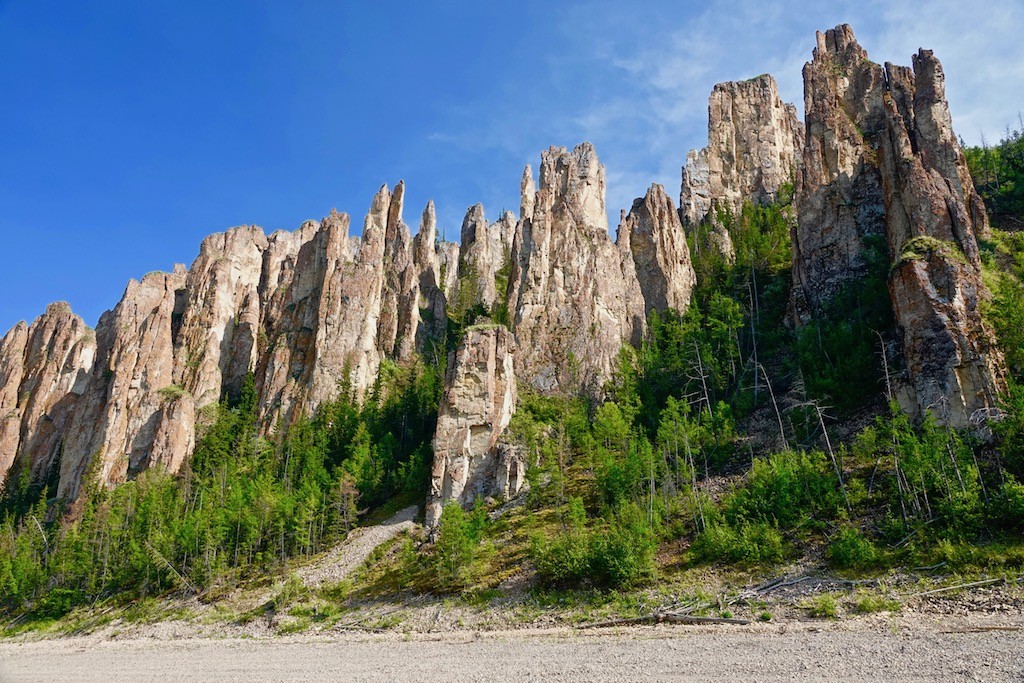
The Lena Pillars near Sinsk village, Khangalas District, Yakutia
The appearance of the Lena Pillars, a forest of rock fingers up to 220 meters tall lining the river banks, indicated that we were approaching Sinsk as our motorboat skimmed over the surface of the Lena, at 4,400 km the longest river in Russia.
Sinsk, the village where my wife’s parents live in the Republic of Yakutia, is located 230km from Yakutsk on the banks of the River Lena. It is classed as a «hard-to-access» settlement, as it has no road and no airport. You can get there only by boat in summer or by driving on the ice in winter. In spring and autumn there is a period of about a month when the ice is too thin to drive on but too thick for boats. At this time Sinsk and many other villages throughout Russia are completely isolated from the outside world. There are even big cities that cannot be accessed overland, although they of course have the blessings of airports, unlike Sinsk.
Trips like this remind you of what it is easy to forget when sitting at your desk in Moscow: Russia, at its central latitudes, is basically one big forest. Almost a quarter of the world’s trees are located here and the country’s total forest cover area is bigger than the entire USA. The edges of many settlements are defined by the point where the houses end and the trees take over. Between villages there is nothing but unbroken forest, sometimes for hundreds of kilometers. Yakutia has a population of only 1 million, of which 350,000 live in the capital Yakutsk, leaving the rest of the India-sized republic is very sparsely populated.
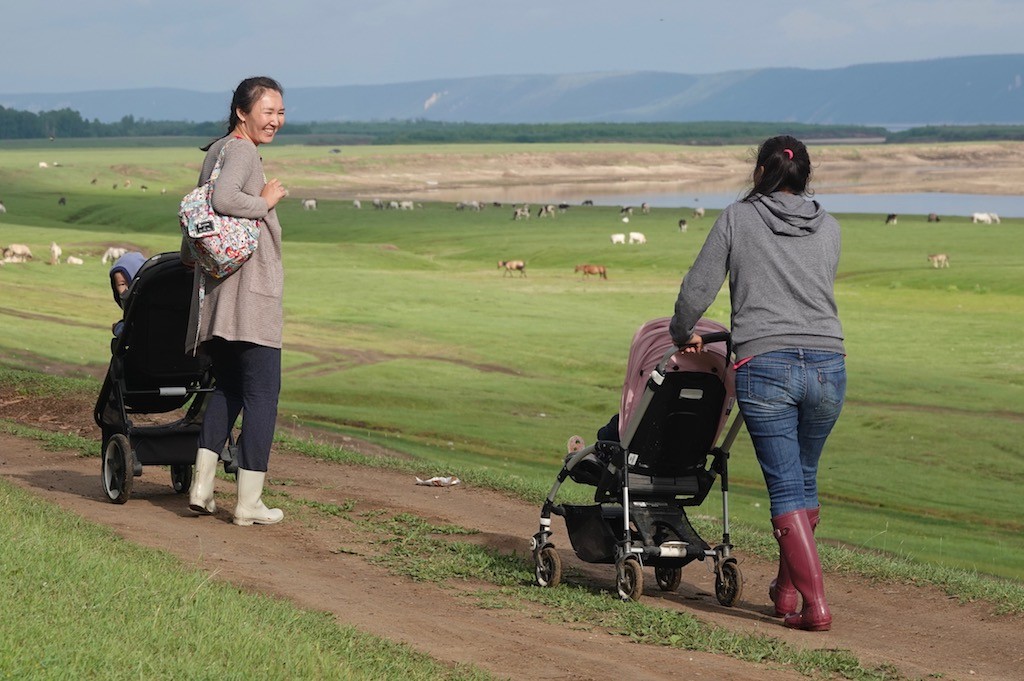
Inhabitants of Sinsk village, Khangalas District, Yakutia
Through this vast forest sneaks the Lena until, like the other two great Siberian rivers the Ob and the Yenisey (and the other great Yakutian rivers, the Yana, the Indigirka and the Kolyma), it breaks out of the taiga forest and into the treeless tundra that covers Russia’s most northern latitudes, eventually emptying into the Arctic Ocean.
Despite being such a huge geographical feature of the country, few Muscovites spare a thought for it or for the hundreds of thousands of peripheral lives lived out on its banks by citizens of Russia – the city dwellers of Yakutsk, the horse herders, hunters and fishermen in the taiga villages, the reindeer nomads and mammoth tusk hunters on the tundra, the polar researchers stationed indefinitely on Arctic Ocean islands around its mouth.
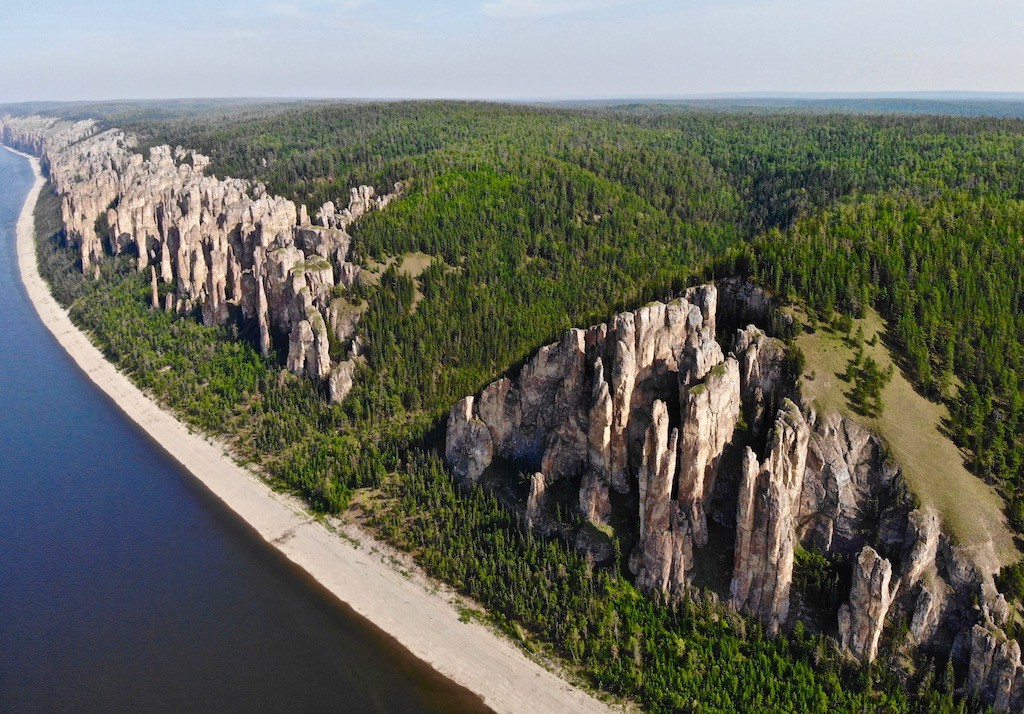
The Lena Pillars near Sinsk village, Khangalas District, Yakutia
Those islands are thousands of kilometers downriver from Sinsk though. For now the dense taiga hugged the banks of the Lena, to our right making way only for the occasional huddle of log cabins and to our left for the Lena Pillars, their dull limestone starkly contrasted against the deep, dark green of the the towering river banks that rose behind them.
Eventually Sinsk came into view, a collection of log cabins beginning at the point where the River Sinyaya flowed into the Lena to our right and continuing for perhaps a kilometer along the top of the raised banks of the Lena. Away from the banks the land on which Sinsk was built climbed steeply upwards, giving us a good view of the village as we approached by boat.
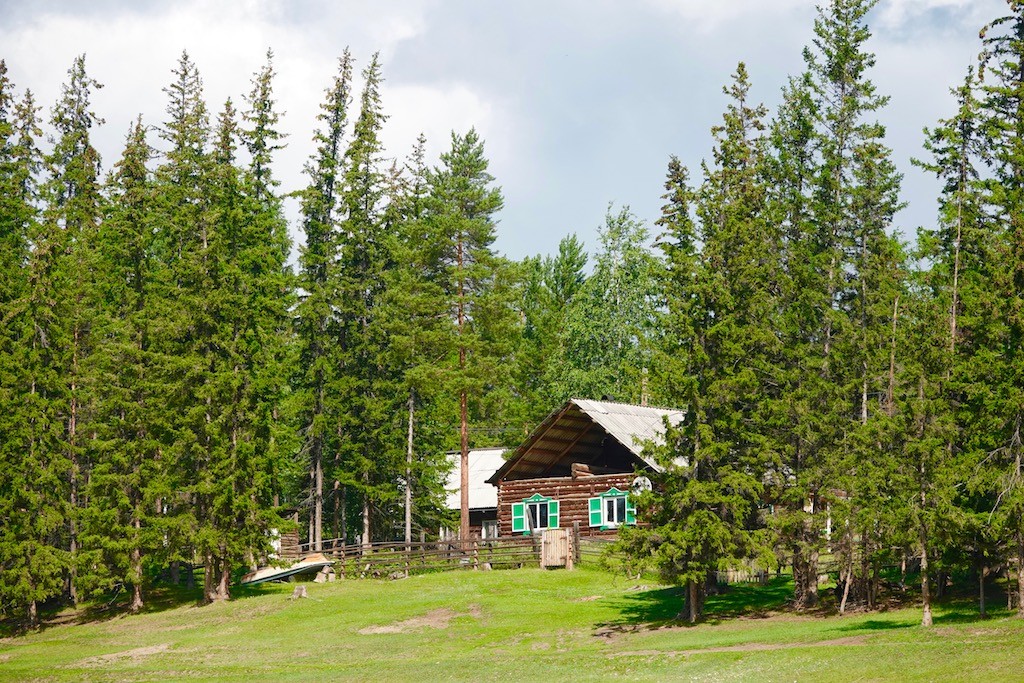
House in Sinsk village, Khangalas District, Yakutia
If one continues 50km down the River Sinyaya, so shallow that this is possible by motorboat only for a brief period during the high water after the ice melts, one reaches the Sinsk Pillars, more beautiful than the Lena Pillars but much harder to access. That, however, is a story for another time…
We disembarked, climbed up the muddy bank and were met by Katya’s father and uncle in one of the old grey Uaz vehicles that are seen so often all over remote parts of Russia and the former USSR. We drove down the muddy track that led through the centre of the village until we came to the house that Katya had grown up in, idyllically situated on the high right bank of the Lena. We passed through the gate in the picket fence, walked past the log pile 6 feet high and hundred feet long, through potato fields until we reached the front door. To the left was another picket fence marking the edge of the garden. Beyond the fence the ground dropped away sharply, providing a spectacular view over fields full of grazing horses, mud flats, a huge island that locals use for hunting and berry picking and the towering left bank of the river several kilometers away.
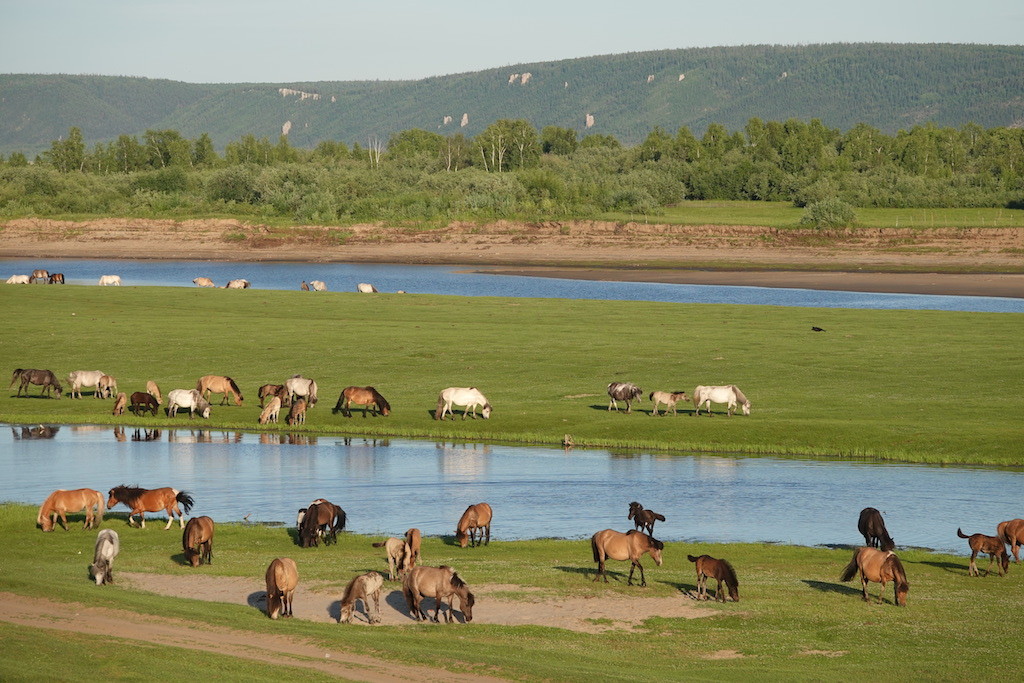
View from Katya’s parents’ house in Sinsk village, Khangalas District, Yakutia
Upon entering, as usual, a huge display of food created us which had somehow been timed to be ready at the exact moment of our arrival. Meat from local horses, cream and butter from local cows, jams from locally collected berries, locally baked-bread, home-cooked pancakes, potatoes grown in the garden and more. All “ecologically clean”, as any Yakut host will be bound to proudly impress on their guests, and all appropriately stodgy for people who do a lot of physical work and spend a lot of time outdoors in the coldest inhabited part of the world. For people who do not, however, it is enough to make you put on several kilograms within quite a short stay, particularly if you have sit down meals four or five times a day as often happens.
And so began our 10 days in Sinsk. What followed was an incredibly relaxing time away from the internet and social media, doing a lot of reading, trying to eat as little as possible of the mouth-wateringly delicious food and occasionally helping the in-laws in the potato field, building a new fence or other small tasks.
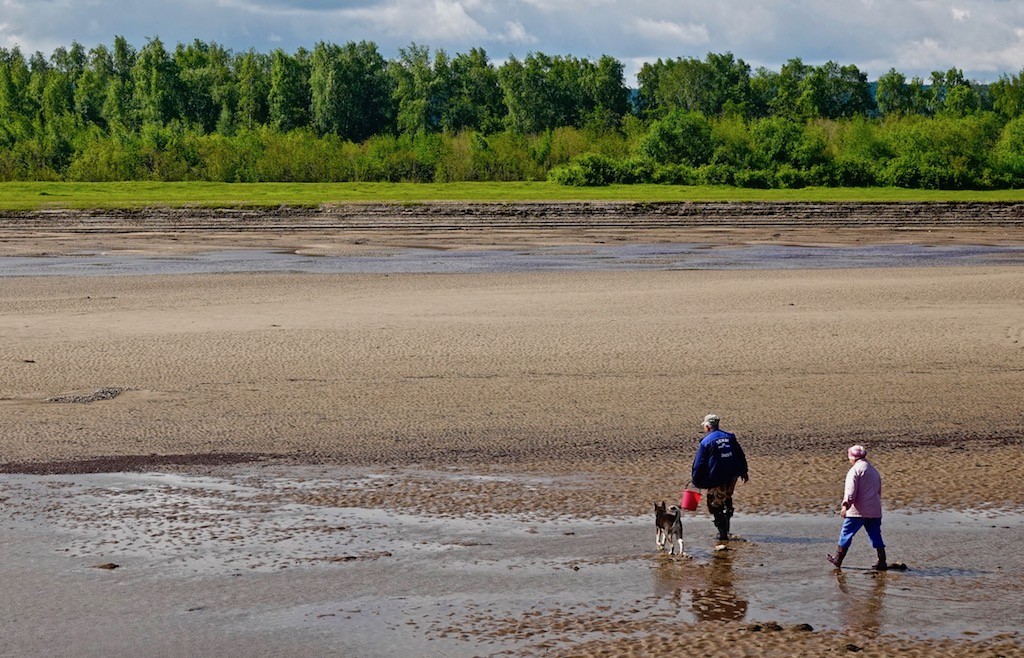
Going to collect berries on the island , Sinsk village, Khangalas District, Yakutia
At first it was cold and windy, which thankfully meant no mosquitoes, but after five days the temperature suddenly shot up to 33°C, which meant they and the midges came out in full force. It was light throughout the night it was possible to admire the view at any time, provided one was not attacked by swarms of flying, stinging critters. I would often stand at the back picket fence, watching the herds of horses slowly graze their way across the fields, listening to them splash through streams and puddles when watering, all undisturbed by the noise of engines or people.
I must say I find the lack of internet somewhat less relaxing than I did five years ago. Back then my tour business had not taken off to the extent it now has and I could comfortably take time off from the web without worrying too much. These days, however, there will invariably be a dozen people trying to get hold of me. And in Sinsk the internet teases you. There is one mobile operator, Megafon, who, if you buy a local SIM card in Yakutsk, will provide that little letter “E” at the top of your phone’s screen that indicates the weakest possible level of internet. You still will not receive any messages unless you work out that you can put your phone onto Airplane mode for a few seconds then turn it off again and at some point over the next couple of hours a load of WhatsApp messages and emails will download. Nothing else, no Facebook or Vyber, just WhatsApp and email, and it takes about 24 hours to send a reply to any of those messages.
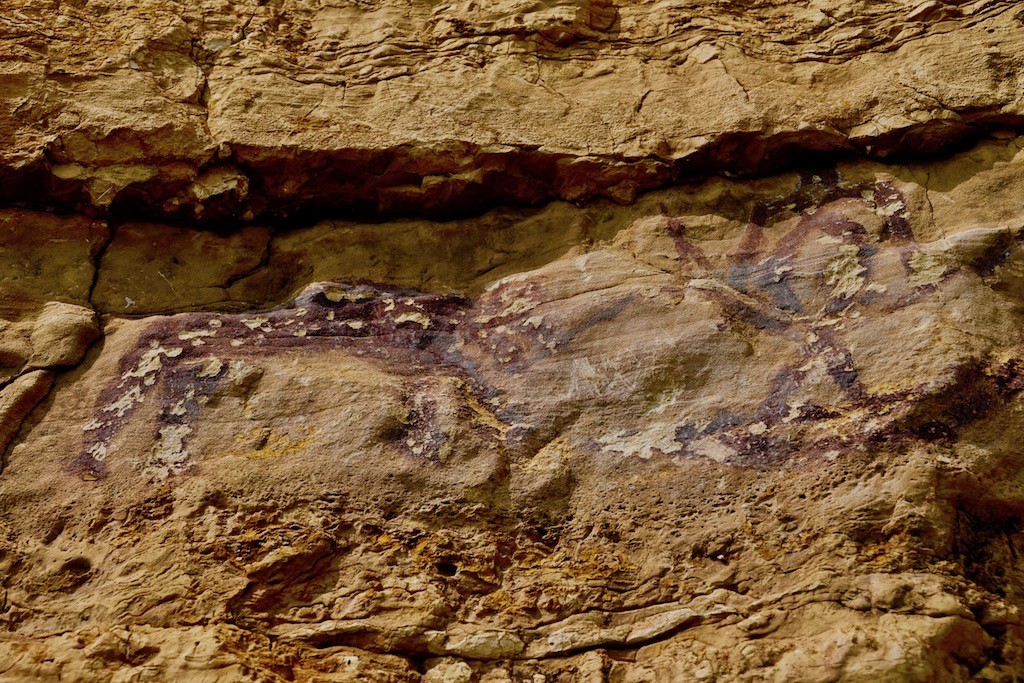
Rock paintings on the Lena River cliffs near Sinsk village, Khangalas District, Yakutia
What this means is that, instead of having no internet at all and just “getting away from it all”, you end up torturing yourself in an endless battle to download and reply to urgent messages from the outside world. One could of course just not purchase that Megafon SIM card in Yakutsk at the beginning of the trip, but one is stupid, an addict and a slave to the world wide web so one does it every time anyway.
SInsk has a lot to recommend it for tourism. It stands on the confluence of the Lena and the Sinyaya, two rivers with Yakutia’s most spectacular forests of rock pillars lining their banks. It is a particularly quaint village made up mostly of log cabins with spectacular views from either above or below. From a cultural point of view it is also interesting, as many of the inhabitants still practice traditional Yakut horse herding and, in winter, can be seen traveling around the village and its surroundings on wooden horse-drawn sledges.
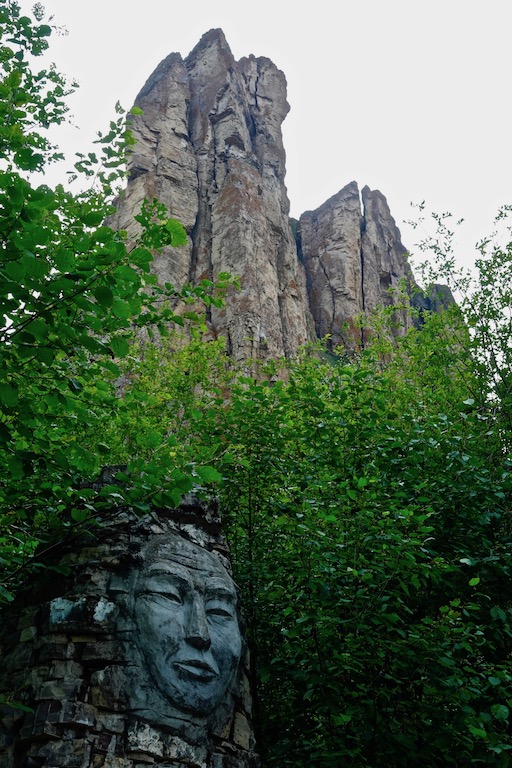
Sacred shamanic site near the Lena Pillars
Interestingly, there are to this day Russian people in Sinsk who have taken up the traditional Yakut activity of horse herding and speak better Yakut (a Turkic language completely unintelligible to Russian speakers) than Russian. Yakut was the only Siberian language which, even after the Russian conquest of Siberia, was actually picked up by some Russians who settled in the area. While some other Siberian languages died out, Yakut flourished and is today spoken as a first language by most Yakut and even by a few Russians in remote villages like Sinsk.
I, however, did not plan on staying that long. We left after ten days, fully refreshed and prepared to deal with the evils of social media and the net once again.
Practical information:
Getting there: There is no public transport to Sinsk and no accommodation there. It is therefore probably best to visit by ordering a tour, for example through my site Travel Yakutia.
When to visit: The ice road works from December to April. You can access it by boat from June to October.
Not to miss: Lena Pillars, Sinsk Pillars, rock paintings, indigenous horse herders.
Extras: As a detour, in winter it is quite easy to visit Buluus glacier by driving across the Lena on the way from Yakutsk to Sinsk.
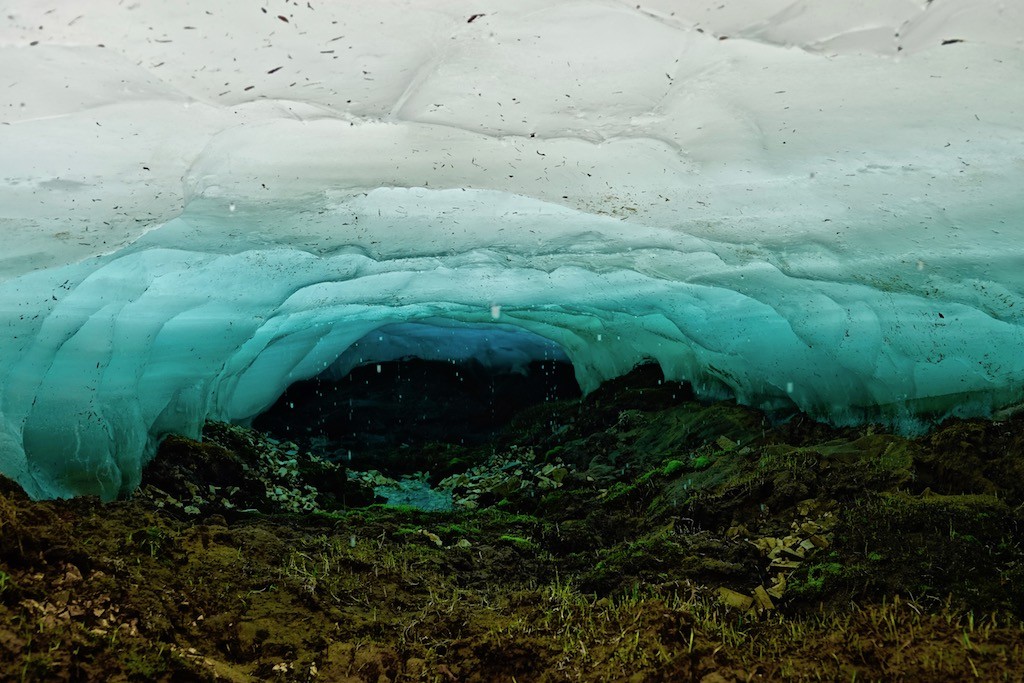
Ice tunnel below the Buluus glacier, Yakutia
Posted in Blog